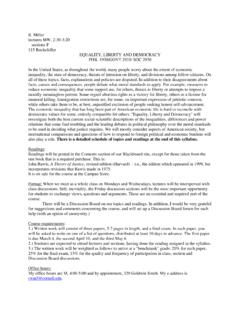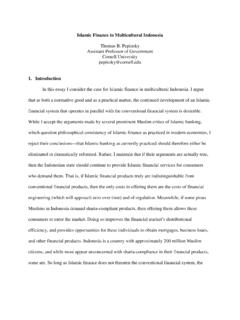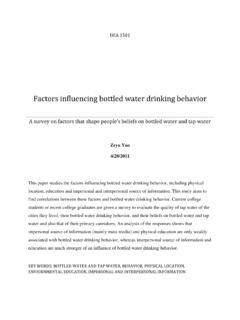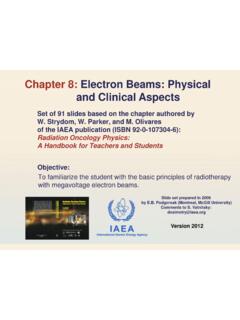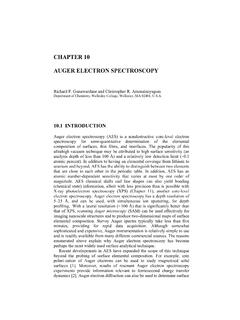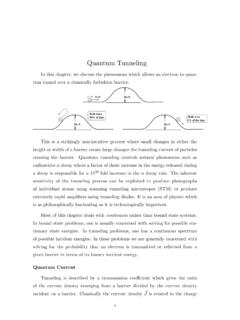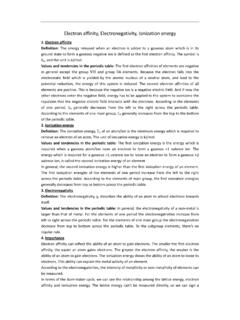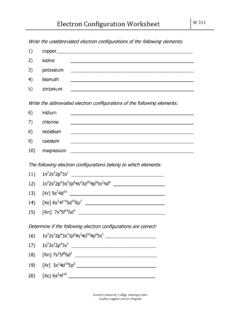Transcription of Lecture 3 Electron and Hole Transport in Semiconductors
1 1 ECE 315 Spring 2005 Farhan Rana Cornell UniversityLecture 3 Electron and Hole Transport in SemiconductorsIn this Lecture you will learn: How electrons and holes move in Semiconductors Thermal motion of electrons and holes Electric current via drift Electric current via diffusion Semiconductor resistorsECE 315 Spring 2005 Farhan Rana Cornell University++++A Silicon crystal latticeholeselectronsReview: Electrons and Holes in SemiconductorsAs+ There are two types of mobilecharges in Semiconductors : electrons and holesIn an intrinsic(or undoped) semiconductor Electron density equals hole density Semiconductors can be doped in two ways:N-doping: to increase the Electron densityP-doping: to increase the hole density As+Donor impurity atoms2 ECE 315 Spring 2005 Farhan Rana Cornell UniversityThermal Motion of Electrons and HolesIn thermal equilibrium carriers ( electrons or holes) are not standing still but are moving around in the crystal lattice because of their thermal energyThe root-mean-square velocity of electrons can be found by equating their kinetic energy to the thermal energy:nththnmKTvKTvm 21212In pure Silicon at room temperature.
2 Scm10~7thvBrownian MotionECE 315 Spring 2005 Farhan Rana Cornell UniversityThermal Motion of Electrons and HolesIn thermal equilibrium carriers ( electrons or holes) are not standing still but are moving around in the crystal lattice and undergoing collisions with: vibrating Silicon atoms with other electrons and holes with dopant atoms (donors or acceptors) and other impurity atomsMean time between collisions= In between two successive collisions electrons (or holes) move with an average velocity which is called the thermal velocity= In pure Silicon, c thcv. Mean distance traveled between collisions is called the mean free pathcthv In pure Silicon, Brownian Motion3 ECE 315 Spring 2005 Farhan Rana Cornell UniversityDrift:Motion of Electrons Under an Applied Electric Field+-VELVE Silicon slabL Force on an Electron because of the electric field = Fn= -qE The Electron moves in the direction opposite to the applied field with a constant drift velocityequal to vdn The Electron drift velocity vdnis proportional to the electric field strength The constant nis called the Electron mobility.
3 It has units: In pure Silicon, EvEvndndn s-Vcm2s-Vcm15002 n ECE 315 Spring 2005 Farhan Rana Cornell UniversityDrift:Motion of Holes Under an Applied Electric Field+-VELVE Silicon slabL Force on a hole because of the electric field = Fp= qE The hole moves in the direction of the applied field with a constant drift velocityequal to vdp The hole drift velocity vdpis proportional to the electric field strength The constant pis called the hole mobility. It has units: In pure Silicon, EvEvpdpdp s-Vcm2s-Vcm5002 p 4 ECE 315 Spring 2005 Farhan Rana Cornell UniversityDerivation of Expressions for MobilityElectrons:Force on an Electron because of the electric fieldAcceleration of the electronSince the mean time between collisions is , the acceleration lasts only for a time period of before a collision completely destroys Electron s velocity So in time Electron s velocity reaches a value This is the average drift velocity of the Electron , Comparing with we get, qEFn nnnmEqmFa c c c Emqancc Emqvncdn Evndn ncnmq Holes.
4 Similarly for holes one gets, pcpmq Special note:Masses of electrons and holes (mnand mp) in Solids are not the same as the mass of electrons in free space which equals ECE 315 Spring 2005 Farhan Rana Cornell UniversityDopant concentration (1/cm3)Mobility (cm2/V-s)Mobility Vs DopingMore doping (n-type of p-type) means more frequent collisions with charged donor and acceptor impurity atoms and this lowers the carrier mobilityNote: Doping in the above figure can either be n-type or p-type5 ECE 315 Spring 2005 Farhan Rana Cornell UniversityDrift Current Density of ElectronsFlux Density: Flux density is the number of particles crossing a unit area surface per second It has units cm-2-s-1 Density: nVelocity: vdnFlux density: nvdnUnit area surface Volume = 1 x (vdnx 1)Area Time Evndn Consider electrons moving under an applied electric field:EECE 315 Spring 2005 Farhan Rana Cornell UniversityDrift Current Density of ElectronsElectrons Drift Current Density: Electron flux density from drift Electron drift current density is,driftnJ EnqvnqqJndndriftn densityflux electronEdnvdriftnJCheck directionsdnvn 22cmAmpss-cmCoulombs driftnJhas units.
5 Evndn EnqJndriftn 6 ECE 315 Spring 2005 Farhan Rana Cornell UniversityDrift Current Density of HolesHoles Drift Current Density:The hole drift current density is , driftpJEdpvdriftpJCheck directions hole flux densitydriftpdppJqqpvqpE 22cmAmpss-cmCoulombs driftpJhas units:Evpdp EpqJpdriftp ECE 315 Spring 2005 Farhan Rana Cornell UniversitydriftnJ EEpnqJJJpndriftpdriftndrift driftpJdriftJTotal Drift Current Density:The total drift current density is the sum of and Conductivity and ResistivityThe quantity is the conductivityof the semiconductor: pnpnq Conductivitydescribes how much current flows when an electric field is applied.
6 Another related quantity is the resistivitywhich is the inverse of the conductivity,Units of conductivity are: Ohm-1-cm-1or -1-cm-1or S-cm-1 Units of resistivity are: Ohm-cm or -cm or S-1-cm 1 7 ECE 315 Spring 2005 Farhan Rana Cornell UniversityExample: A Semiconductor ResistorLA AreaVI+-Silicon slabFor a resistor we know that,RVI We also know that,VLAALVAEAJI drift 1 2 ALALR 21 pnpnq 1 whereLessons: Knowing Electron and hole densities and mobilities, one can calculate the electrical resistance of Semiconductors n-doping or p-doping can be used to change the conductivity of Semiconductors by orders of magnitudesECE 315 Spring 2005 Farhan Rana Cornell UniversityDiffusionDiffusion of ink in a glass beakerWhy does diffusion happen?
7 8 ECE 315 Spring 2005 Farhan Rana Cornell UniversityDiffusion and DiffusivityThere is another mechanism by which current flows in Semiconductors .. Suppose the Electron density inside a semiconductor is not uniform in space, as shown belowxn(x)slope dxxnd Since the electrons move about randomly in all directions (Brownian motion), as time goes on more electrons will move from regions of higher Electron density to regions of lower Electron density than the electrons that move from regions of lower Electron density to regions of higher Electron density Netelectron flux density in +xdirectionelectron flux in +xdirectionelectron flux in -xdirection dxxndDdxxndn The constant Dnis called the diffusivityof electrons (units.)
8 Cm2-s-1)ECE 315 Spring 2005 Farhan Rana Cornell UniversityDiffusion Current DensityElectrons Diffusion Current Density: Electron flux density from diffusion Electron diffusion current density is,diffnJ22cmAmpss-cmCoulombs dxxndDqqJndiffn densityflux electronxdiffnJCheck directions dxxndDn diffnJdiffpJHoles Diffusion Current Density:Hole flux density from diffusionHole diffusion current density is,diffpJ dxxpdDqqJpdiffp flux hole dxxpdDp and has units xnElec. fluxxdiffpJCheck directions xpHole flux9 ECE 315 Spring 2005 Farhan Rana Cornell UniversityEinstein RelationsEinstein worked on other things besides the theory of We introduced two material constants related to carrier Transport :1) Mobility 2) Diffusivity Both are connected with the Transport of carriers (electrons or holes) It turns out that their values are related by the Einstein relationshipsEinstein Relation for Electrons:Einstein Relation for Holes:qTKDnn qTKDpp Kis the Boltzman constant and its value is.
9 Has a value equal to Volts at room temperature (at 300 oK)KJoules qTKIn pure Silicon, This implies,s-Vcm15002 n s-Vcm5002 p pDExample:ECE 315 Spring 2005 Farhan Rana Cornell UniversityTotal Electron and Hole Current DensitiesElectrons: dxxndDqxExnqxJxJxJnndiffndriftnn Total Electron and hole current densities is the sum of drift and diffusive componentsHoles: dxxpdDqxExpqxJxJxJppdiffpdriftpp Electric currents are driven by electric fields and also by carrier density gradients10 ECE 315 Spring 2005 Farhan Rana Cornell UniversityThermal Equilibrium - IThere cannot be any net Electron current or net hole current in thermal equilibrium.
10 What does this imply ??Consider electrons first: 00 dxxndDqxExnqxJxJxJonnodiffndriftnn 1 1can also be written as: xEKTqdxxndo log dxxdxE Since the electric field is minus the gradient of the potential:We have: dxxdKTqdxxndo log KTxqoexn constantThe solution of the above differential equation is:But what is that constant in the above equation ???ECE 315 Spring 2005 Farhan Rana Cornell UniversityThermal Equilibrium - II KTxqoexn constantWe have:Note: one can only measure potential differences and not the absolute values of potentials Convention: The potential of pure intrinsic Silicon is used as the reference value and assumed to be equal to for intrinsic Silicon, constantconstant KTxqoexn But we already know that in intrinsic Silicon, ionxn So it must be that,in constantAnd we get the final answer, KTxqioenxn Consider Holes Now: One can repeat the above analysis for holes and obtain: KTxqioenxp 2ioonxpxn Check.


